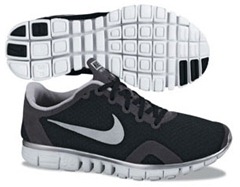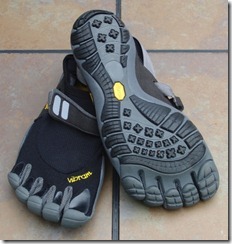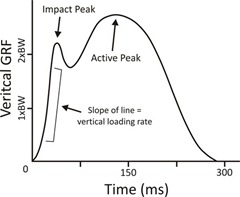 Several interesting studies have come out over the past few weeks that have in one way or another focused on the running foot strike. The first that I’m going to cover is by Jason Bonacci and colleagues and addresses how running mechanics differ between barefoot running and running in a “minimalist” shoe (Nike Free 3.0), racing flat (Nike Lunaracer 2), and “regular” running shoes (a runner’s typical training shoe, variable by individual). The study is titled “Running in a minimalist and lightweight shoe is not the same as running barefoot: a biomechanical study” and was released in Online First form on the British Journal of Sports Medicine website.
Several interesting studies have come out over the past few weeks that have in one way or another focused on the running foot strike. The first that I’m going to cover is by Jason Bonacci and colleagues and addresses how running mechanics differ between barefoot running and running in a “minimalist” shoe (Nike Free 3.0), racing flat (Nike Lunaracer 2), and “regular” running shoes (a runner’s typical training shoe, variable by individual). The study is titled “Running in a minimalist and lightweight shoe is not the same as running barefoot: a biomechanical study” and was released in Online First form on the British Journal of Sports Medicine website.
Methods
The authors recruited 22 highly trained, high-level runners (mean 10K time of 33 minutes) and provided them each with a pair of Nike Free 3.0 and Nike Lunracer 2 running shoes. They were given 10 days to run a few times barefoot and in the new shoes so that each condition would not be entirely novel. They also ran in their usual running shoe (which was on average about 125-140g heavier than the two lightweight shoes).
The researchers filmed the runners with a 22-camera 3D Vicon system on an indoor track, and measured force using 8 force plates (this was a pretty high-caliber setup). The combination of cameras and plates allowed them to capture biomechanical data from a 20m long section of the track.
After a warmup, Each runner performed 10 running trials in each of the four conditions (barefoot, Free, Lunaracer, variable standard shoe). Average speed was 4.48m/s (about 6:00/mile) during the trials, so they were running far faster than most recreational runners.
Results
The results of the study basically showed that running barefoot is a lot different than running in shoes, but that the three shoe conditions didn’t differ all that much.
The only real difference between the shoes was that runners tended to have shorter, quicker strides in the Frees and Lunaracers vs. their standard shoe (mean cadence 183.9 steps/min for both lightweight shoes vs. 181.3 steps/min in standard shoe). The Nike Free did reduce peak ankle adduction during stance and increased peak ankle internal rotation moment equivalent to barefoot, but in all other respects was more similar to the other shoes.
The real standout here in terms of biomechanical differences was barefoot running. Here are some of the key differences that were found for barefoot relative to the shoes:
1. shorter stride length than all shod conditions
2. higher cadence than all shod conditions (avg. 187.7 steps/min)
3. less dorsiflexion of the ankle at initial contact (i.e., flatter foot placement at contact)
4. greater ankle plantarflexion at toe-off
5. reduced knee extension and abduction moments
6. less knee flexion during midstance (straighter leg)
7. smaller joint moments and less work done at the knee (24% less negative work when barefoot compared to the standard shoe)
8. greater joint moments and more work done at the ankle
The authors summarize by saying: “Knee and ankle mechanics when running barefoot were different to all shod conditions, including the minimalist shoe, indicating that the minimalist shoe cannot entirely replicate the mechanics of running barefoot.”
Thoughts
This study provides further confirmation for a pattern that we are starting to see over and over. That is: barefoot running mechanics are different than shod running mechanics, particularly when comparing barefoot to a well cushioned shoe. Barefoot running tends to reduce work done by the knee and increase work done by the ankle. From a therapeutic standpoint, barefoot running may have benefits to those with knee issues, but may put the foot, ankle, Achilles, and calf at greater risk. Thus, knowing the individual runner and their needs/weaknesses is critical to avoid trading one set of injuries for another.
What I particularly liked about this study is that the authors were very open about admitting its limitations. For example, they point out the the Nike Free has quite a bit of cushion and an elevated heel. Habitual barefooters jump all over anyone who claims that the Nike Free replicates barefoot running, and this study seems to prove them right, at least in terms of how it affects biomechanics (and much to the chagrin of Nike marketing…). Studies of less cushioned shoes (e.g., Vibram Fivefingers) have revealed more similarity to barefoot running, but even ultraminimal shoes don’t seem to be a perfect mimic to running without footwear. They also admit that by not controlling the standard shoe they may have not as easily detected differences between the minimal and more traditional shoes.
Another important point that the authors emphasize is that their subjects were very highly trained runners and that as a result they might “already have highly consistent running mechanics and different types of shoes have little influence on their running gait.” They indicate that “It is possible that lesser trained runners with less consistent mechanics may be more susceptible to changes in running gait when utilising a minimalist shoe.” As always, one must consider the subjects and conditions studied when applying the results of a scientific study, and I’d once again love to take a look at individual variation.
The authors end the paper with the following conclusion, which I feel is a very nice summary of the implications of their study:
“In conclusion, the dynamics of running overground while barefoot are different to that of running in a minimalist shoe that has cushioning and an elevated heel. Athletes and their coaches should not expect to instantly replicate barefoot running while in a minimalist shoe. Running barefoot does induce mechanical changes to habitually shod highly trained runners gait and it is inherently different to shod running. The increase in work done at the ankle must be considered when transitioning to running barefoot as too rapid a transition may overload the triceps surae complex. Conversely, the reduction in joint moments and work done at the knee while running barefoot may provide potential benefits for the management of knee pain and injury.”
You can read the abstract to Bonacci et al., 2013 here: http://bjsm.bmj.com/content/early/2013/01/10/bjsports-2012-091837.full



















Hi Pete,
I spoke with Vicenzino (one of the co-author) about this study some months ago at the world PT congress IFOMPT… and he was wearing Vfingers :)
I fully agree with your comment. The 3 most important points about this study are, for me: 1. The population used (like you explain) 2. The shoes they used are not so minimalist (TRC rating 67% and 66%) 3. The individual answer (that we don’t know here): some of my patient runners change their biomechanics with minimalist shoes (TRC rating 60%) …some don’t with ultra minimalist shoes like VFingers (TRC rating 90%)… the reason why we personalized our prescription.
blaise
Exactly. I see students of mine switch to forefoot immediately when they take their shoes off and run for the first time, others still heel strike barefoot on asphalt. Each case is a bit different. But, I think it is becoming clear that barefoot is very different, even compared to some very minimal shoes, though they may in turn be different from more heavily cushioned shoes..
—-
Pete Larson’s Web Links:
-My book: Tread Lightly: link to ow.ly
-Blog: https://runblogger.com
-Twitter: link to twitter.com
-Facebook Page: link to facebook.com…
-Discussion Forum: https://runblogger.com/forum
Agree.
But more your shoes are maximalist, more your chances to run differently than barefoot are high… and more you run minimalist, more your chances to run closer to barefoot are high
how do you know that soreness in one’s ankle foot is do to the transition to forefoot running and not due to a particular shoe? in theory, shouldn’t everyone feel some strain alleviated in the knee and increased in the ankle/foot when making the transition?
after switching to “barefoot” shoes 2 and a half years ago, and also going almost barefoot completely the last 3 months, my form is SIGNIFICANTLY better, i didn’t necessarily have to bad of form, but there have been significant changes in everything i do, standing, walking, running, jumping, almost everything bio mechanically is better than it used to be
it’s good to see more tests confirm differences
Awesome. I would really appreciate it if you could pass along the reference to the paper describing what ‘better’ running form is.
well really, it’s not just one paper, but many different sites and whatever, drawing bits and pieces from them
and also understanding the main concepts of how the body wants to be while unaltered by any footwear…i mean i was just able to pick it up myself so you’d have to probably search around
at the moment, i can’t remember unfortunately….however, Dr. Mark Cucuzella from natural running center basically nailed it and i fixed some minor things that i didn’t picj up before, that and my track coach Anthony Veney…both of those teachings combined helped me get it down…
so yea, this video, and googling barefoot running as well as Anthony Veney, as he has some videos up that can help translate
hope that helps
Here’s the video Cody referred to, great resource! link to youtube.com.
Sent from my iPad
lol, i forgot, remembered, and forgot again to post the link of that video
c’mon brain :P
also, here’s a conveniently new article on pose running vs natural running also by Dr. Mark Cucuzella
http://naturalrunningcenter.co…
Mark’s a brave guy to wade into that debate :)
—-
Pete Larson’s Web Links:
-My book: Tread Lightly: link to ow.ly
-Blog: https://runblogger.com
-Twitter: link to twitter.com
-Facebook Page: link to facebook.com…
-Discussion Forum: https://runblogger.com/forum
am i brave for being on his side? lol
no but really, interesting stuff, i started off pose running-ish and kept fixing and tweaking after that, which ended up following the “natural running” form, which imo seems to be spot on
not knocking on pose running, but i would say i’m on mark’s ‘side’ as some of the pose running aspects seems a bit…”jerky”? and kind of…break the “flow” of going forward
No, I’m on his side too :)
—-
Pete Larson’s Web Links:
-My book: Tread Lightly: link to ow.ly
-Blog: https://runblogger.com
-Twitter: link to twitter.com
-Facebook Page: link to facebook.com…
-Discussion Forum: https://runblogger.com/forum
What about speed? There is but one reference here to “average” speed during the trials. These runners are fast, but that average is an otherwise meaningless number. If you want to run faster, you’re going to want a bit of cushion, biomechanics be damned, right? More interesting than any of this pseudo-analysis is what changes the study subjects made, if any, after the study. They are individuals, after all.
A limitation that the authors didn’t seem to recognize, at least in the quotes presented, is that some aspects of the barefoot condition might be different if the the runners were more habituated to barefoot running. 10 days is hardly time to get over the tentativeness that might lead to a shorter stride length and higher cadence.
Another tantalizing study – interesting, but falls a little short of a what it would be nice to see done to tease out the relationship between shoes and running form. It would be nice to repeat the study with a wider range of shoes type – in particular some genuinely minimal shoes like Vivobarefoot/Vibrams/Bare-X 180’s.
Allowing the running to run for a few minutes in a particular shoe condition for a few minutes before testing is appropriate for a short term study but it’s the longer term adaptations that are the key differences that we should be interested in.
Another aspect I’d like to see is the how individuals respond to different stimulus.
It rather feels that we are getting lots of little pieces of the jigsaw from various studies and we can use these a certain amount about the gaps in between these jigsaw pieces, but it’s oh so frustrating that the jigsaw pieces are a bit too mis-shapen to easily fit them together into a single compelling picture.
Good article on a very controversial topic at the moment, I have been involved in some very heated debates with some passionate people who swear by barefoot and those who have a more cynical approach to its practicality. I am a believer in natural processes in everything I do
and try to stay as close to the way it “should be” as much as
realistically possible – I have written more on my thoughts here in this
article –
http://www.lovefitnesseducatio…